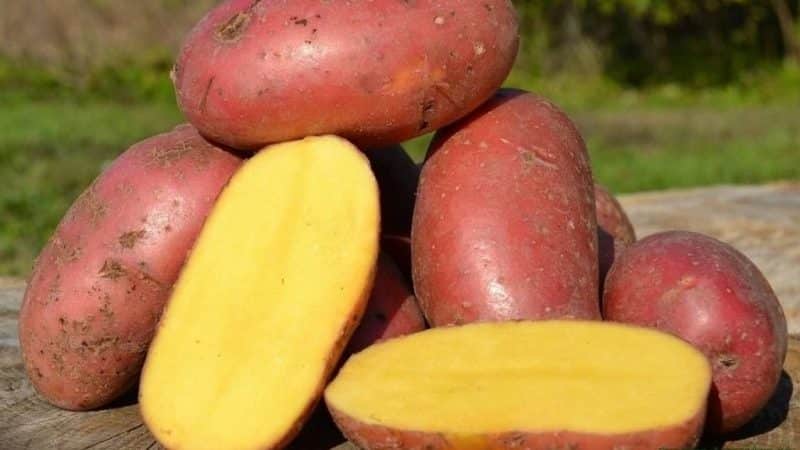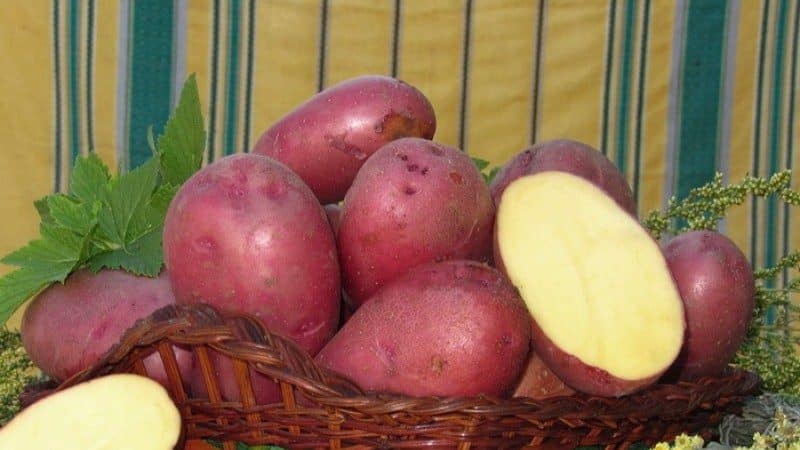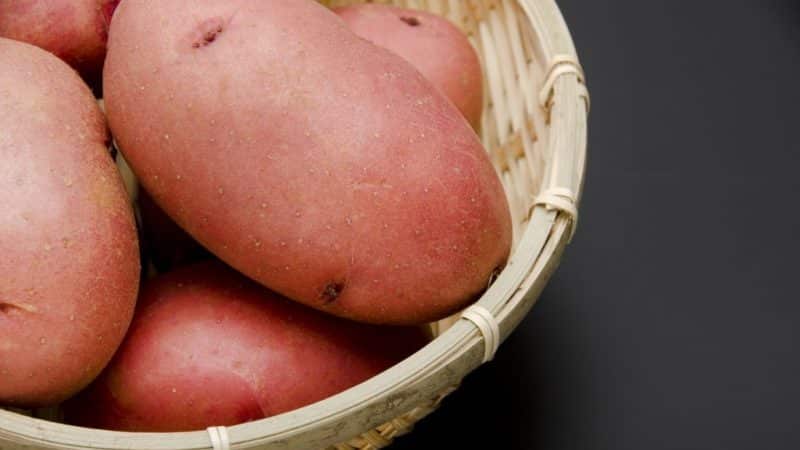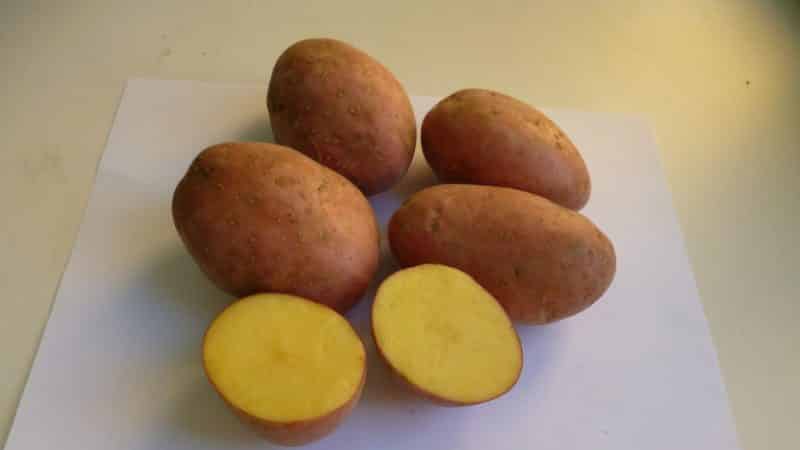Mid-early table potato variety "Laura" with excellent taste and aroma
Laura potatoes are a productive variety bred by German breeders. Its tubers have an attractive presentation and excellent taste. The plant is easy to care for and can grow in any climate zone. This makes it popular not only in Russia, but also in Europe.
Description of the variety
The culture is widespread in the Central and Northwestern regions of Russia, Europe, but is not included in the State Register of the Russian Federation.
Origin and development
The company Europlant Pflanzenzucht GmbH (Germany) decided to create a variety that would surpass the well-known Scarlett potato in yield. As a result of breeding work, a new variety, Laura, appeared, which has higher productivity compared to other varieties of red-skinned potatoes.

Distinctive features
The variety is mid-early: an average of 90 days pass from germination to technical maturity of tubers.
Characteristics of tubers:
- the peel is smooth, dark pink in color, there are small superficial eyes;
- the pulp is dense with a yellow tint;
- regular oval shape;
- weight - 90–150 g;
- length - from 7 cm;
- starch content - 15–17%;
Important! Potatoes are valued for their amount of starch. So, if it contains 14–25%, then it is considered “high-starchy,” that is, tasty.
Characteristics
Laura's bushes are spreading, tall and erect. The leaves are dark green with a wrinkled structure, without pubescence, located intermediately. There are many inflorescences. The flowers are white or purple.
The variety is high-yielding, but the performance varies depending on the weather and time of planting. About 20 tubers are obtained from one bush. An average of 330 centners are collected from 1 hectare.
How to grow
Laura potatoes successfully tolerate almost any climatic conditions. It grows well in any soil, loam and sandy loam. The highest productivity is shown in black soil regions, but in arid regions the productivity of the variety is low.

Planting dates and scheme
The timing of planting varieties depends on the region. In cold soil, potatoes will rot and will not sprout, and late April frosts will completely destroy the plantings. Therefore, in the southern regions Laura is planted at the end of April, in the northern regions - in mid-May. The soil should be warmed up to +7...+8°C at a depth of 9-10 cm.
Before planting, seed potatoes are prepared. To do this, it is first sorted out, leaving only medium-sized, intact and disease-free tubers.
The next stage is germination for 12–14 days in the sun or light. Then the tubers are treated with products based on zinc, boron or manganese, and sprayed with a solution of gibberellin or sodium humate.
Mineral and bacterial additives are added to the soil:
- superphosphate in granules;
- urea;
- nitrogen-bacterial fertilizing "Ecofit";
- nitrophoska;
- phosphorus-bacterial “Bactophosphine”;
Planting is carried out according to the standard scheme:
- Dig holes no more than 10 cm deep. If the soil is not fertile enough, then add humus or a handful of ash to the depressions.
- The distances between the holes are 30–40 cm.
- 60–70 cm are left between the rows to provide the bushes with aeration and simplify hilling.
Important! Potatoes are not planted next to tomatoes: they have the same diseases and pests.
After planting, the ground is leveled with a rake. During the flowering period, the flowers are picked off so that the tubers receive more nutrients.
Care
To obtain a large harvest, potatoes are provided with proper care. The Laura variety loves watering: it is irrigated at least 3 times per season:
- For the first time - 3 weeks after germination.
- Then before the flowers appear on the tops. During this period, the crop needs water most.
- Water the last time before the end of flowering. After waterlogging of the soil leads to the development of fungal diseases.
Proper soil treatment plays an important role in maintenance. The formation of large tubers depends on this. The main nuances of soil cultivation around potatoes:
- Weeds are removed throughout the growing process: they take nutrients from the ground, attract pests and shade young potato sprouts.
- The soil around the bushes is regularly loosened: this ensures access of water and air to the roots.
- Potato beds are mulched with dry straw to reduce the frequency of watering and weed growth.
- After the tops grow to a length of about 20 cm, the bushes are hilled to saturate the roots with oxygen, increase the number of new stolons, and increase productivity.
- After the first hilling, the procedure is repeated every 3 weeks.
The crop reacts negatively to a lack of potassium in the soil, so it is fed with potassium magnesium throughout the growing season. The product improves the quality of tubers by increasing the amount of starch in them.
Nuances of cultivation and possible difficulties
Although Laura potatoes are easy to care for, there are some difficulties in cultivating them:
- need for frequent watering;
- proper care of the soil in the beds;
- preparing soil and potato seeds before planting;
- compliance with the bush placement scheme;
- compliance with crop rotation rules;
Diseases and pests dangerous to the variety:
- Blackleg. A characteristic sign is a black coating on the lower part of the stem. The tops turn yellow and rot, and are easy to pull out of the ground. The tubers are covered with wet mucus. The disease has no cure. Affected bushes are removed, the soil is disinfected with a solution of 1 tbsp. l. copper sulfate with 1 tbsp. ash.
- Colorado beetle. Insects lay eggs on the leaves, and beetle caterpillars (larvae) eat the tops. This significantly worsens the harvest. If the number of adults and larvae is small, they are collected by hand. In case of severe damage, use the Kinmiks insecticide according to the instructions.
- Wireworm. The pest makes tunnels in the tubers, as a result the potatoes are not stored for long. To combat wireworms, fresh potatoes and carrots are placed on wooden sticks and buried to a depth of about 10 cm. After some time, they are removed from the soil along with the insects.
- Medvedka. The insect lives underground, eats roots and tubers. They get rid of it with an infusion of hot pepper and water or with the help of chemicals.
The variety is resistant to nematodes, leaf curl, Y-virus and scab, and has relative immunity to late blight.
Important! The last chemical treatment against pests is carried out no less than 30 days before harvest.
Harvesting and application

Potatoes are harvested when the tops wither and turn yellow. To do this, dig up the bushes from the side with a pitchfork, put the tubers in a container and leave them to dry. Afterwards, rotten and damaged potatoes are sorted and removed.
Keep vegetables in a cellar or basement at a temperature of +1...+3°C. Laura's shelf life is 90%: it is perfectly preserved until next summer.
Potatoes are used to prepare various dishes and soups. It is stewed, fried, baked, boil.
Advantages and disadvantages of the variety
Advantages of Laura potatoes:
- high productivity;
- large smooth tubers;
- excellent taste;
- average early maturity;
- resistance to some diseases and pests, weather conditions;
- long shelf life;
Flaws:
- low resistance to mechanical damage to tubers: they immediately deteriorate;
- preference for soil varieties rich in potassium;
- negative reaction to the herbicide “Metribuzin” (it is used for treating weeds);
Farmer reviews

Laura has a high rating and many positive reviews from gardeners. They are mainly attracted by the even shape of the tubers and their pleasant taste:
Georgy, Naberezhnye Chelny: “I liked the variety. The tubers are large, as in the photo, and are stored for a long time. We sell the leftovers at the market; we don’t have time to eat everything ourselves. I recommend trying it."
Marianna, Moscow: “I tried Laura for the first time while visiting a neighbor. What a great taste! The potatoes don't get soggy, they're crumbly, I'm delighted. Now I also grow this variety on my plot.”
Peter, Barnaul: “I planted Laura’s tubers and was pleasantly surprised that, apart from the Colorado potato beetle, there were no diseases. There is no escape from the beetle anywhere. Processing only. The variety itself is good, high-yielding.”
Read also:
Domestic potato variety "Aurora".
Conclusion
Laura is a high-yielding crop that produces smooth tubers with crumbly starchy pulp and a characteristic potato aroma.The variety is unpretentious in care: agricultural technology for its cultivation includes standard techniques (regular watering, fertilizing, hilling, weed removal). Laura is successfully cultivated in various regions of the country.